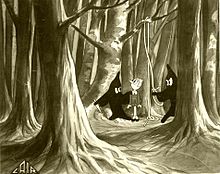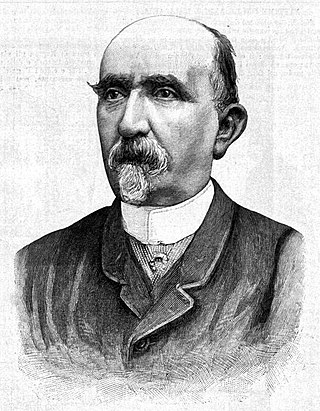
Carlo Lorenzini, better known by the pen name Carlo Collodi, was an Italian author, humourist, and journalist, widely known for his fairy tale novel The Adventures of Pinocchio.
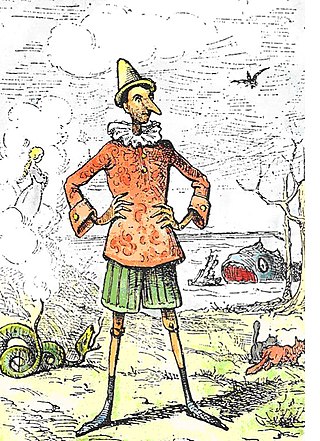
The Adventures of Pinocchio, commonly shortened to Pinocchio, is an 1883 children's fantasy novel by Italian author Carlo Collodi. It is about the mischievous adventures of an animated marionette named Pinocchio, which he faces many perils and temptations, meets characters that teach him about life, and learns goodness before he achieves his heart's desire of becoming a real boy.
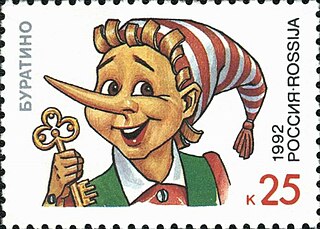
Buratino is the main character of Aleksey Nikolayevich Tolstoy's 1936 fairy tale The Golden Key, or the Adventures of Buratino, which is based on the 1883 Italian novel The Adventures of Pinocchio by Carlo Collodi. Buratino originated as a character in the commedia dell'arte. The name Buratino derives from the Italian burattino, which means "wooden puppet" or "doll". The book was published in 1936; the figure of Buratino quickly became hugely popular among children in the Soviet Union and remains so in Russia to this day. The story has been made into several films, including the animated 1959 film and the live-action 1975 film.

The Fox and the Cat are a pair of fictional characters and antagonists of Italian writer Carlo Collodi's 1883 book Le avventure di Pinocchio. They are depicted as poor con artists who hoodwink Pinocchio and attempt to murder him. They pretend to be disabled: the Fox lame and the Cat blind. The Fox appears to be more intelligent than the Cat, who usually limits himself to repeating the Fox's words.

Mangiafuoco is a fictional character who appears in Carlo Collodi's 1883 Italian book The Adventures of Pinocchio, serving as a secondary antagonist turning good.

The Coachman, also known as The Little Man, is a fictional character and a major antagonist from Carlo Collodi's 1883 book The Adventures of Pinocchio, in which he appears in chapters XXXI and XXXIII.

The Terrible Dogfish is a dogfish-like sea-monster, which appears in Carlo Collodi's 1883 book The Adventures of Pinocchio as the final antagonist. It is described as being larger than a five-story building, a kilometer long and sporting three rows of teeth in a mouth that can easily accommodate a train. So fearsome is its reputation, that in Chapter XXXIV, it is revealed that the Dogfish is nicknamed "The Attila of fish and fishermen".
Pinocchio is a character from the 1883 novel The Adventures of Pinocchio
The Nastro d'Argento is a film award assigned each year, since 1946, by Sindacato Nazionale dei Giornalisti Cinematografici Italiani, the association of Italian film critics.

Pinocchio is a fictional character and the protagonist of the children's novel, The Adventures of Pinocchio (1883) by Italian writer Carlo Collodi of Florence, Tuscany. Pinocchio was carved by a woodcarver named Geppetto in a Tuscan village. He is created as a wooden puppet, but he dreams of becoming a real boy. He is known for his long nose, which grows when he lies.

The Adventures of Pinocchio is a 1972 Italian animated fantasy film produced by Cartoons Cinematografica Italiana. An adaptation of Carlo Collodi's 1883 book The Adventures of Pinocchio, it is written, produced, directed and edited by Giuliano Cenci. The English dub was released in the United States by G.G. Communications in 1978.

The Talking Cricket is a fictional character that appears in the 1883 Italian book The Adventures of Pinocchio by Carlo Collodi.

The Green Fisherman is a fictional character who appears in Carlo Collodi's book The Adventures of Pinocchio.

Candlewick or Lampwick is a fictional character who appears in Carlo Collodi's 1883 book The Adventures of Pinocchio.
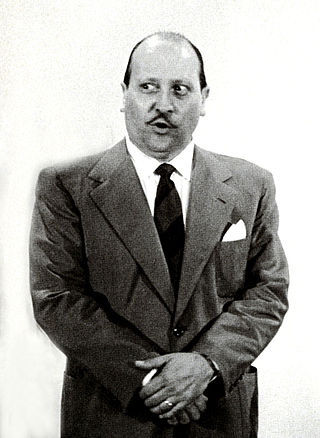
Carlo Romano was an Italian actor, voice actor and screenwriter.

Romolo Bacchini, also credited as Bachini was a filmmaker, musician, painter and Italian dialect poet, who spent his career during the silent film era.
Antonio Negri (1881–1966) was an Italian poet, best known for his works in Milanese language. He began writing in 1931, after retiring from work and relocating to Montevecchia, in Brianza, and was later a prolific author. One of his prominent works is On soldaa papà, inspired by On papà soldaa by Giannino Sessa. While both works are based on the theme of a girl whose father dies in World War I, Negri's version is crudely anti-rhetoric and conveys pacifist values that openly contrasted those promoted in Italy by the Fascist regime of the time.
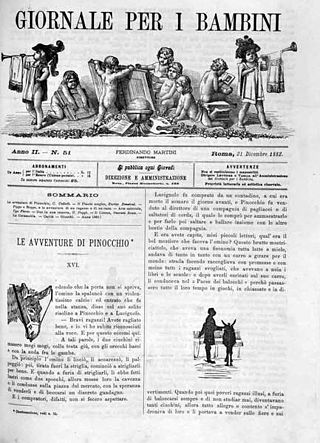
Giornale per i bambini was an Italian weekly periodical published in the 1880s by Tipografia dei Fratelli Bencini and later Tipografia Bodoniana. It first appeared as an insert in Fanfulla della domenica in 1881, and established as an independent publication later that year by Ferdinando Martini, who was also the periodical's first editor. The target audience was children between the ages of 6 and 12. The publication was owned by Ernesto Emanuele Oblieght, a Hungarian financier who also owned a number of other children's publications.

The Adventures of Pinocchio is a 1911 Italian live-action silent film directed by Giulio Antamoro and starring Ferdinand Guillaume.
Events in 1872 in animation.



